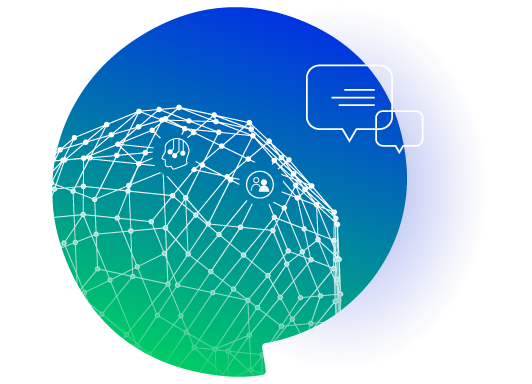Every company out there is trying to be more customer-centric, and the race for an excellent customer experience is heating up. Creating a positive customer journey — from the first interaction to the purchase and even after the sale is made – is paramount if you want to attract and retain customers. 91% of customers agree that ‘a positive customer service experience makes them more likely to make another purchase.’
Any company trying to improve customer experience should follow a defined plan so that their strategy is aligned with customer expectations. If you already have a clear idea about improving customer experience and want to grow your business with Comm100, click here to book a personalized demo. If you’re still exploring, here is a detailed step-by-step guide to setting goals and strategizing for customer experience improvement.
Customer Service Industry Trends 2024
Discover the most impactful & lasting industry trends in 2024 and beyond.
Explore the trends
Report
1. Set Clear Objectives
The first step to improve customer experience should be to ask yourself what exactly you plan on accomplishing.
Nine out of ten managers confirm that customer experience is a strategic objective for increasing sales and revenue. However, most managers do not ask what the end goal is before engaging in a CX improvement project.
A clear understanding of your business objectives is required. After identifying these objectives, you should identify who will be affected, and effectively prioritize and segment these people.
For example — identify which customers will be affected, what importance do each customer group have, and set out why they need a CX improvement. Other people affected include the employees on the frontline, for example, call center agents and sales representatives.
Here are some examples of objectives:
a. Business objectives
Some of the business objectives you can use include customer retention, customer satisfaction, product purchases, purchase volume, purchase frequency, products returned, the number of dissatisfied customers and revenue.These objectives allow you to evaluate the effectiveness of your customer experience strategy to convert into business results. They should be quantifiable and measurable.
b. Customer experience objectives
Examples of CX objectives include; giving customers more control, creating partnerships that improve customer experience (e.g. collaborating with a payment or shipping company), identifying target markets, increasing responsiveness and so forth.Certain pitfalls must be avoided in this step, such as accounting for insufficient customer data, lack of business data and avoiding the assumption that all customers in your target group have the same views.
2. Understand Customer and Market Perceptions
Customer experience improvement is centered on the perceptions of the customer, not the business.
In order to improve CX, you should understand the customer’s idea of an ideal interaction. This includes the needs at every stage of the CX life cycle, interactions with your business and the difficulties they encounter. The CX program should be from the customer’s perspective, which can be achieved by:
- Collecting customer experiences and views
- Identifying gaps in the customer experience
- Conducting internal workshops
- Mapping the customer journey
- Conducting customer, market, and employee research
Failing to include customers and stakeholders at all levels will be detrimental to your customer experience improvement efforts. It should be noted that the right customers should be involved, for example, the customers in your target group according to age, gender, location and so forth.
3. Developing the CX Strategy
Now that you know your objectives and have carried out the research, it’s time to develop a strategy that will guide your customer experience.
This phase involves planning a strategy that consistently meets customer expectations or “ideal experiences”. When developing your strategy, you will understand what resources are required, the time it will take and the specific activities you need to carry out changes.
Prioritize activities and allocate them to employees. It is also imperative that you start instilling a customer-focused attitude among employees through workshops and training, as well as ensuring your own stated values and behavior role-model what you want to achieve.
Here are some activities to consider:
- Define the strategy
- Create business cases and situations
- Identify gaps in the current CX strategy
- Get buy-in from executives by involving them in the project
The strategy should be tied to your brand and customers should associate your brand with the experience.
Involving executive management and staff is crucial. From your objectives, you should outline the expectations of your project, which employees can use to monitor progress and achieve the desired customer experience.
Read more: The Ultimate Guide to Launching and Branding a Successful Customer Experience Program
4. Set Quarterly Milestones that Are in Line with Objectives
This is an extension of the strategy development phase. Setting goals to be achieved quarterly will motivate employees and keep them focused. These goals will also be a yardstick to measure the success of your strategy. The achievement of these goals has to be tied to the overall objectives outlined in step one. Using our business objectives, you can develop some questions such as:
- What can we do to reduce the number of returned products to >5% this quarter?
- Which strategy can we use to increase how frequently existing customers buy our products?
- How can we reduce delays to customer calls and increase responsiveness this quarter?
- What actions will improve our customer satisfaction ratings?
- What initiative can help increase customer retention by 1% this quarter?
- These questions can be used to measure up against the quarterly goals.
Progress should be reviewed constantly and in a systematic manner. Team meetings, for instance, should be used to monitor progress and individuals should be assigned activities that will help in achieving the goals. Also, outline progress indicators which can be reviewed in periodic meetings.
5. Design Customer Service Protocols
Guided by the ideal customer interaction and the CX strategy, develop a protocol for customer service that will consistently offer value over the long term.
Remember that these protocols will differ with customer groups because of their different needs. Developing this framework will help you create positive touchpoint experiences that customers can come to expect from your brand. The activities to be carried out in this step include;
- Designing specific customer experiences that meet customer expectations
- Defining metrics and key performance indicators
- Create a framework to outline priorities
- Map out an implementation map and journey map
- Redesign current processes and services
One way to do this is to involve employees (especially those who interact with customers) in role-playing activities, or by creating a persona of a customer.
For example, Juliet is 26 years old, does her shopping online through her phone and uses the live chat feature for customer support, while 44-year-old John collects coupons from his mailing list to shop at your store, and prefers physically visiting your customer care desk.
This will help create a model for interacting with the two completely different customers and help you to deliver their ideal experiences.
Apart from this, your protocols should outline the activities that happen behind the scenes to create the customer experience. Interdependencies will be uncovered and the interaction with people, technology, and touch points will be smoothed out as a result.
6. Implement the CX strategy
Next, using the material from the previous step, implement the customer experience strategy, starting internally.
This means training employees, redesigning systems, establishing internal communication channels and aligning rewards with the achievement of set goals.
Implementation is often time-consuming and resource-heavy because all staff must be involved. Executive management needs to support the initiative and lower tier employees need to be shown the importance of the initiative.
Additionally, employee rewards must be tied to goal achievement so that they can support the CX strategy. Customer experience will be driven by the customer-centric organizational culture – it’s a win-win situation once you have your program off the ground.
This exercise can also help to bridge operational gaps that hinder customer service, like departmental communication barriers.
Activities included in this step are:
- Planning and executing internal communications
- Training
- Improving touch points and customer interactions
- Empowering employees to offer insight and ideas to improve the strategy
- Testing the strategy on preselected customers
Read more:AI Chatbots are Improving Customer Experience Faster than Expected
7. Monitor the System and Make Improvements
After delivering the system to the customer, the company should monitor how effective it is in improving the customer experience. It will take some time to measure effectiveness, and you should compare the results with internal goals and metrics.
Customer feedback is very important and you should listen to customers to know where the system is failing. This can be done by measuring customer perceptions after they are introduced to the new system.
Other metrics to measure progress with are external metrics, monitoring your competition’s customers, and listening to employee feedback.
You should also compare the customer experience between different customer groups and make specific improvements to the affected areas. The following activities can help in making improvements:
- Gather customer experiences from the new system
- Evaluate its impact on business objectives
- Track and monitor performance using KPIs
- Collect and act upon customer insights
Continuous improvement is required after this stage too, since market forces are dynamic and the customer’s idea of an “ideal experience” can change over time. Therefore, it is important to continually monitor the customer experience and act on data collected.
Conclusion
Most managers, when tasked with customer experience improvement, look to create a new strategy that will radically change the way they do business. However, a more incremental approach as we’ve described ensures constant improvements, at a manageable scale.
Building upon the existing customer experience is the best strategy for success here, and by following these steps, you can ensure that you can plan, implement and track improvements to your service, helping you to demonstrate real business benefit.
Customer Service Industry Trends 2024
Discover the most impactful & lasting industry trends in 2024 and beyond.
Explore the trends
Report







